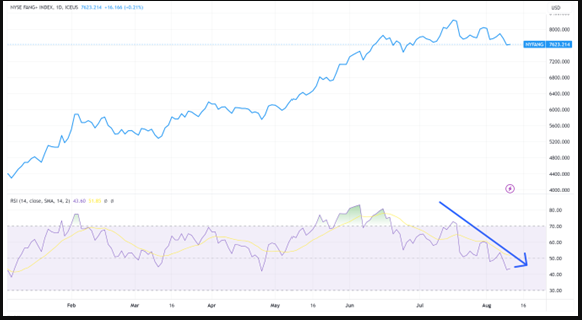Momentum vs fundamentals
Disinflation versus deflation.
Momentum versus fundamentals.
Price versus earnings.
This week's What’s Not Priced In episode is all about contrasts.
Greg Canavan and I discuss the diverging economic fortunes of the US and China, momentum trading pulling valuations away from fundamentals, and the listless Aussie market.
Greg then explains why commodities still offer long-term value, exploring some unloved but enticing mining services stocks.
I chip in with a quick discussion of why high P/E stocks are not always expensive and low P/E stocks not always cheap.
And, finally, when the market is dull, pick up a book!
Investing is a multiplayer game
What’s Not Priced In is all about the idea that investment outperformance resides on the outer. You won’t beat the market by being where the market is.
A crowded trade is a middling trade. The more people about, the less chance of finding a $100 note lying around.
So, sometimes I like to preface the show with sage advice from investing’s luminaries.
This week, the honour fell to Stephen Penman and Steven Crist.
Finance professor Penman summed up the whole game with this:
‘Valuation is not a game against nature, but a game against other investors, and one proceeds by first understanding how other investors think. As an investor, you are not required to establish a valuation, but only to accept or reject the valuation of others.’
Crist is not an investor, but a punter famous in the horse racing scene. But betting has its similarities to investing, as Crist explained here:
‘The issue is not which horse in the race is the most likely winner, but which horse or horses are offering odds that exceed their actual chances of victory.
‘Under this mindset, everything but the odds fades from view. There is no such thing as “liking” a horse to win a race, only an attractive discrepancy between his chances and his price.’
‘The only path to consistent profit is to exploit the discrepancy between the true likelihood of an outcome and the odds being offered.’
The odds being offered by Mr Market matter just as much as your own assessment of an outcome’s likelihood.
It’s the discrepancy between the two that makes the opportunity.
But right now, the market is focusing too much on momentum … and even that is losing steam.
Momentum waning and the benefits of patience
The ASX 200 is trendless. And US stocks have stalled their recent ascent.
CNN’s Fear & Greed Index finally notched lower from Extreme Greed to ‘just’ Greed, sliding from 77 last month to 68.
The higher the reading, the greedier the market:

For Greg, the US stock market is dominated by quantitative trading. You could say the machines are in control.
On Wall Street, momentum is king. The trend is the lodestar.
As a result, huge amounts of capital are crowding into the same theme (tech and AI), but as we pointed out last week, that momentum trade is starting to wane.
Here’s the NYSE Fang+ Index, comprising the biggest tech stocks like Meta, Apple, Amazon, Google, and Microsoft.
As you can see, the Relative Strength Index (RSI) indicates momentum is flagging:

So what does the dissipating momentum mean for the wider market? What’s next?
Watch the full episode for our thoughts!
In any case, it’s important to remember not everyone invests like you.
As Greg pointed out, the biggest thing for value investors here is patience.
China and the US on divergent inflation paths
First China’s exports and imports both fell sharper than expected in July…
Now China’s inflation is going backwards.
China’s economy fell into deflation for the first time since February 2021. The country’s Consumer Price Index slumped 0.3% year-on-year in July.

Cornell University professor Eswar Prasad bleakly said:
‘The Chinese economy is now at serious risk of sliding into a deflationary episode that could spark a self-reinforcing downward spiral in growth and private sector confidence. The government needs to act quickly and decisively to put a floor on growth and limit deflation before matters get out of hand.’
With China’s latest CPI falling into negative territory, some may be asking why deflation is a problem. Surely a falling aggregate price level is a good thing?
Not so.
Here’s Justin Wolfers and Betsey Stevenson explaining the dangers in their macro textbook:
‘Deflation sounds great—things are getting cheaper! But it can cause problems because falling prices leads people to delay spending today, in favour of buying stuff in the future when prices are even lower. This decrease in aggregate expenditure will reduce output, which leads prices to fall further, setting off a vicious cycle of deflation, reducing spending, which creates yet more deflation. Worse, this cycle of deflation might lead the inflation rate to become more negative, which raises the real interest rate (which is the nominal interest rate less this negative inflation rate), which further depresses spending.’
Deflation reduces aggregate demand and deepens an economic slump.
China doesn’t want that. Neither, of course, do its trading partners.
Where do commodity prices go from here?
So where are commodity prices headed from here?
How much does China’s economic slump matter?
In 2019, the Reserve Bank released a research bulletin on the spillover effects to Australia from China’s economy.
Here’s a key excerpt:
‘China is a key source of demand in a number of major commodity markets and, as a consequence, a slowdown in economic activity in China could lead to sizeable falls in some commodity prices.
‘A substantial slowdown in Chinese economic growth could have a significant impact on global confidence and financial markets, especially equity prices, with implications for confidence and financial conditions in Australia.
‘Falls in commodity prices would have direct implications for mining revenues and investment, and indirect consequences for government revenue, shareholder profits and the demand for (and wages of) workers in the resources sector.’
Clearly China’s struggles to jump-start its economy after extensive lockdowns are well known and well documented.
So are China’s struggles therefore well and truly priced into commodities like iron ore and copper?
Or is the pessimism around China’s economy a contrarian opportunity or a contrarian death trap?
We covered these questions extensively in the pod, so tune in for the answers.
High P/E stocks not always expensive
This week’s episode also featured a discussion about valuations and whether price/earnings multiples can tell us anything.
Some of you may have already read my piece on the matter, where I shared this incredible chart from fund manager Terry Smith:

The chart shows the P/E multiple you could have paid for select stocks in 1973 and still beaten the MSCI World Index by the end of 2019.
During the period, the index returned 6.2% a year. But you could have bought L’Oréal for 281 times earnings and still outperformed.
The takeaway?
High P/E stocks are not always expensive. Low P/E stocks are not always cheap.
In fact, low P/E stocks often end up expensive, while high P/E stocks grow to be cheap.
Here’s another chart from Smith.
It shows the performance of familiar low PE stocks between 2015 and 2020 versus the performance of high P/E stocks:

As you can see, by 2020, many ‘value’ stocks became expensive or lacked earnings altogether.
Conversely, many seemingly overpriced growth stocks in 2015 became attractively valued by 2020.
Smith’s charts are very neat.
But for every L’Oréal, there’s bound to be dozens of high P/E L’Oreally duds.
The real trick is not knowing that some high P/E stocks can still offer value, but knowing which ones.
For Greg, it’s a case of hindsight analysis in that there are hundreds of very high PE companies that blow up, and only a few that ‘make it’ and justify their high price.
Greg thinks it’s a low-probability game trying to pick the winner.
For others, the low chances are precisely what attracts them to the search. Like hedge fund manager Philipe Laffont.
In a discussion of his investing methodology, Laffont echoed the message evoked in Smith’s charts, saying (emphasis added):
‘In 2007, Apple traded at 30x EPS but only 3x five years out.
‘The art of growth investing is realizing a stock that appears expensive today can be dirt cheap 5-7 years later. Multi-baggers are the source of most outperformance and hide many mistakes.’
The art of growth investing may be simple enough. It’s the craft of assembling accurate forecasts that’s harder.
Mining services stocks
During a gold rush, it’s good business to sell picks and shovels.
And if commodities are set for long-term structural tailwinds, mining services stocks are ones to watch.
During the episode, Greg profiled three mining services stocks the market has neglected for well over a year.
Do they offer value here?
Watch on for the answer!
When the market gets dull, read a book
We are saturated with content — with the nutritional equivalent of processed food.
Our eyes feast on empty calories of popular news, entertainment, pop culture, and social media.
Even content’s favoured son, Robert Downey Jr, is fatigued, admitting his Marvel stint as Iron Man was nothing more than ‘content’.
Marvel is to entertainment what Henry Ford was to transportation. Both found success pioneering mass production at scale.
Ford had the Model T, Marvel had the Avengers.
And investing is not immune to content-fication.
How much of our daily financial press intake is of the empty calorie variety?
Daily gyrations of the stock market are infused with easy explanations, and the conveyor belt of news never stops delivering neatly packaged stories of big gains and losses.
The itch to act is aggravated.
FOMO trading is not a new phenomenon, so much as an epiphenomenon of mass content.
How many investors FOMOed into AMC Entertainment or GameStop or an altcoin at the peak of their coverage?
Investing is a patience game played in a 24-hour news cycle.
Sometimes it pays to just take a break from it all.
The market gets a bit dull? Close the laptop, switch the TV off, and open a book.
Greg recommended Adam Zamoyski’s Phantom Terror: Political Paranoia and the Creation of the Modern State, 1789-1848.
And I’ve just started Robert A Caro’s The Power Broker.
Enjoy the episode (and happy reading)!
5 topics
1 contributor mentioned
.png)
.png)